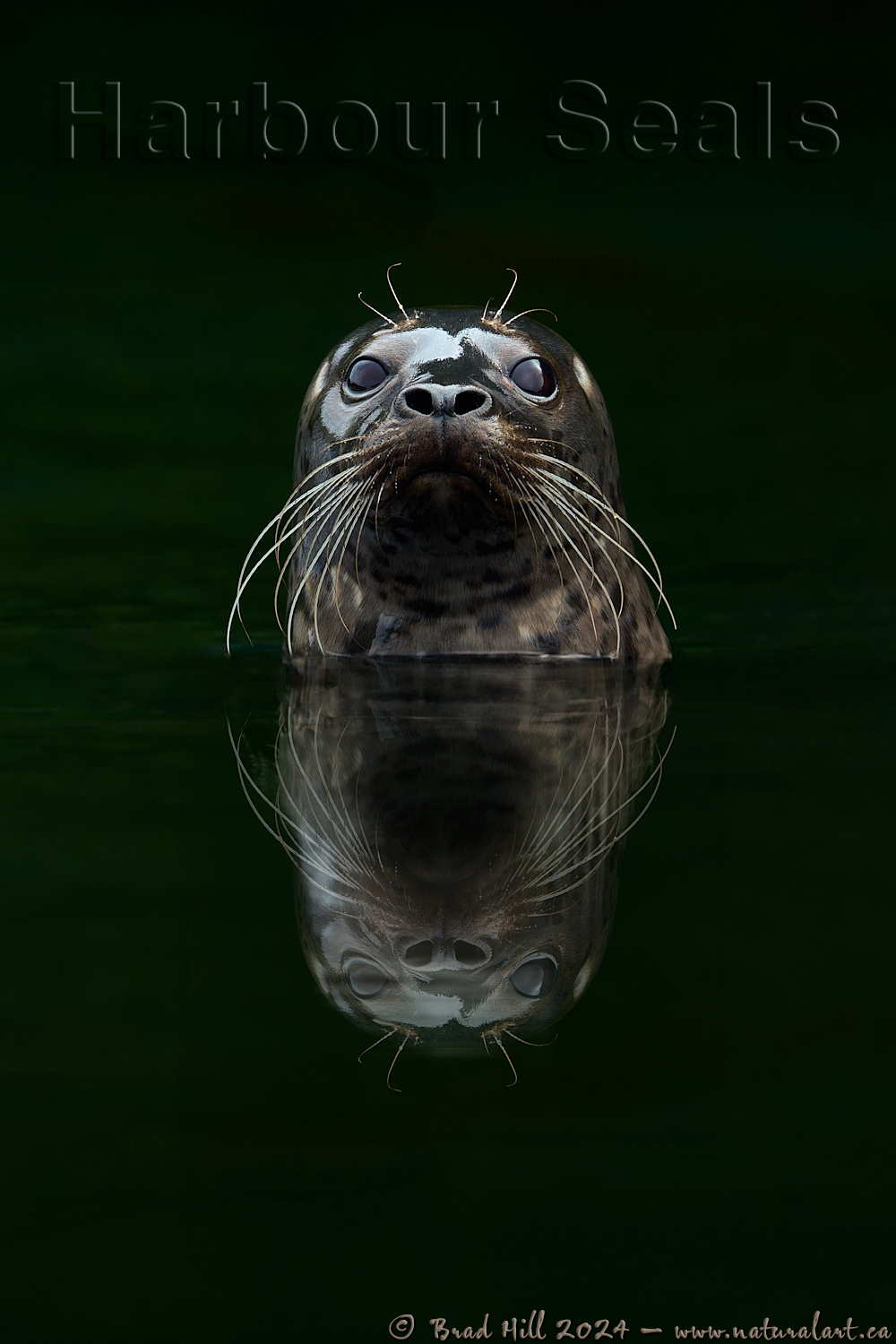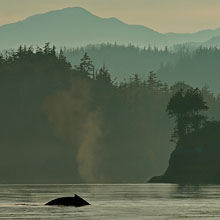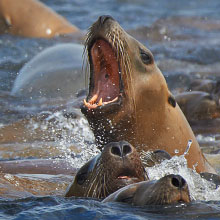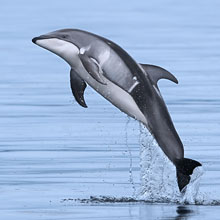Availability: Undetermined - Enquiries?
In the Field
Calm. Curious. Harbor Seal. Queen Charlotte Strait, British Columbia, Canada. October 18, 2023.
View additional Harbour Seal images beginning here: Harbour Seals
Many of the photographers who have accompanied me on photo tours on the BC coast know that I have been trying to capture a very specific image of a Harbor Seal for close to two decades. In fact, my pursuit of this image (which until recently only existed in my mind's eye) has almost become a standing joke among the guides I work with on the BC coast. The image? A Harbor Seal in calm, dark, dark water staring directly at me and with absolutely wonderful lighting on it. Over the years I have come close to capturing my seal image a number of times, but invariably something happened to thwart me (most often it was simply that the seal disappeared below the surface before I captured the shot). However, during my "Autumn in the Queen Charlotte Strait" photo tour in 2023 we encountered a number of seals in a kelp bed that were very calm and very curious about us. And...finally...everything came together and I captured my "dream" Harbor Seal shot. THIS is that shot! I guess I can retire happy now, eh?
Kidding aside, my pursuit of this image brings to mind an interesting phenomenon that has reared its head multiple times on my photo tours. Many photographers who join me on these tours come with the goal of capturing a specific image - some times it's a very specific image (e.g., a backlit Spirit Bear posing on a log with a distant out-of-focus background) and other times it's just an image type (e.g., a shot of a swimming grizzly). In most cases the photographers pursuing a specific image or image type are not completely obsessed with "meeting their goal" and are more than happy to photograph whatever subject matter we're presented with. But occasionally I have someone on a trip who is completely and totally focused on getting "their" image and couldn't be bothered photographing anything else. In some cases, these photographers don't even allow themselves to see other great photo ops they're being presented with - functionally they have shut down their "opportunity recognition" system! Occasionally these "driven" photographers do capture their dream image and go home happy, but more commonly they fail and end up disappointed. In contrast, those who come on my tours with the mindset of capturing great images of whatever they are presented with invariably have a great time and go home with a number of excellent images (often of a wide array of subjects).
Back to my comment above about retiring (now that I have my seal shot). Nah...I'm not about to retire. Not only do I have a lot of other very specific images of a variety of wildlife subjects that still exist ONLY in my head (and NOT in my image collection), but I can still improve on my "Harbor Seal in calm, dark, dark water staring directly at me" image. The BEST Harbor Seal image hasn't been captured yet (and never will be) - but the next time I'm out I just may capture a better one!
Here's a larger version (3600 pixel) of my own personal Holy Grail image:
• Calm. Curious. Harbor Seal: Download 3600 pixel image (JPEG: 2.0 MB)
ADDITIONAL NOTES:
1. These images - in all resolutions - are protected by copyright. I'm fine with personal uses of them (including use as desktop backgrounds or screensavers on your own computer), but unauthorized commercial use of the image is prohibited by law. Thanks in advance for respecting my copyright!
2. Like all photographs on this website, these images were captured following the strict ethical guidelines described in The Wildlife FIRST! Principles of Photographer Conduct. I encourage all wildlife photographers to always put the welfare of their subjects above the value of their photographs.
3. This image was captured during my Autumn in the Queen Charlotte Strait exploratory photo adventure in October of 2023. Each year I offer trips into two different parts of the Great Bear Rainforest as well as two tours into the Khutzeymateen Grizzly Sanctuary (to photograph grizzlies, of course!). Details about these trips can be found on the Photo Tours page of this website.
Behind the Camera
Calm. Curious. Harbor Seal. Queen Charlotte Strait, British Columbia, Canada. October 18, 2023.
High Efficiency* Compressed RAW (NEF) format; ISO 1100.
Nikon Z 9 paired with Z Nikkor 800mm f6.3S. Hand-held from floating Zodiac. VR on in Sport mode. 3D-tracking AF area mode with subject detection on Birds mode.
1/1000s @ f6.3; -1.3 stop compensation from matrix-metered exposure setting.
At the Computer
Calm. Curious. Harbor Seal. Queen Charlotte Strait, British Columbia, Canada. October 18, 2023.
Initial noise reduction and capture sharpening on the .nef (raw) file using the DeepPRIME XD algorithm of DXO PhotoLab 7.6 Elite (using the appropriate lens/camera optical module).
Subsequent adjustments to the adjusted linear DNG file (exported from PhotoLab) and conversion to 16-bit TIFF file (and JPEG files for web use) - including all global and selective adjustments - made using Phase One's Capture One Pro 23. In the case of this image the only global adjustment was an overall contrast tweak (using the Levels tool). Selective local adjustments performed using Capture One Pro's layers and masking tools. In this case numerous small adjustments and tweaks were made on 4 separate layers, with most of the tweaks being associated with "exposure balancing" and contrast adjustments (such as adjustments to clarity, highlights, shadows, etc.).
Photoshop modifications included insertion of the watermark and/or text.
Conservation
Calm. Curious. Harbor Seal. Queen Charlotte Strait, British Columbia, Canada. October 18, 2023.
Species Status in Canada*: Most Harbour Seal populations in Canada are not listed as Threatened or Endangered. The Lac des Loups Marins landlocked population of Quebec (Ungave Peninsula) currently listed as Endangered (most recent assessment update - November 2007).
The Harbour Seal (Phoca vitulina) is found on both the eastern and western coasts of North America. They tend not to make long migrations and in many areas they are present year-round. When foraging Harbour Seals normally dive to between 30 and 100 metres in depth and stay below the surface for 5 to 6 minutes. On occasion they have been known to dive to depths of over 450 metres and have stay submerged for almost 30 minutes. Harbour Seals have a diverse diet, including cephalopod, crustacceans and a variety of fish such as herring, eulachon, pollock, and salmon.
Historically bounty programs were used in both Canada and the USA to reduce populations of Harbour Seals. In more recent times seals have become protected over much of North America and some populations have rebounded strongly (it is estimated that over 150,000 seals now occupy the coast of British Columbia). There is a land-locked and freshwater sub-species of the Harbour Seal found on the Ungava Peninsula of northern Quebec. This population is now down to an estimated 100 individuals and is listed as Endangered by COSEWIC.
*as determined by COSEWIC: The Committee on the Status of Endangered Wildlife in Canada.
























